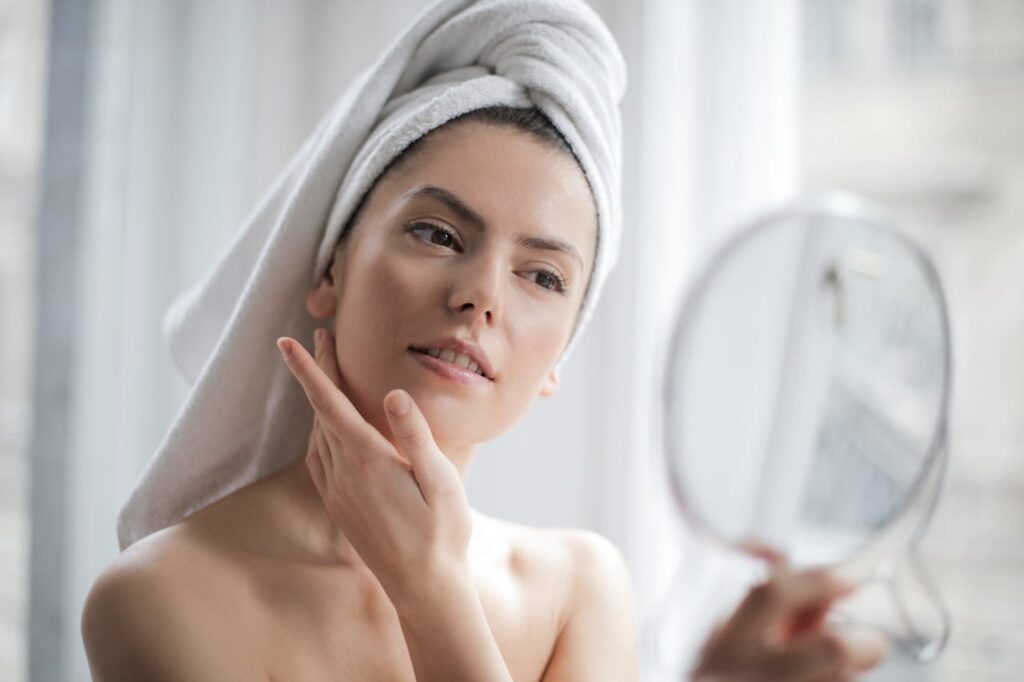Introduction
In today’s digital world, we spend hours every day in front of screens — phones, laptops, tablets, and TVs. While most people know about the dangers of UV rays from the sun, few realize that blue light (HEV light) emitted from digital devices can also affect skin health. Recent studies suggest that overexposure to blue light can accelerate skin aging, trigger pigmentation, and weaken the skin barrier. The good news? Organic skincare offers natural, antioxidant-rich protection that helps defend your skin from this modern-day stressor.

What Is Blue Light and Why Does It Matter?
Blue light, or high-energy visible (HEV) light, sits next to UV light on the electromagnetic spectrum. It has a shorter wavelength and higher energy than other visible light, which allows it to penetrate deeper into the skin.
Unlike UV rays, blue light doesn’t cause immediate sunburn — but it can cause oxidative stress, inflammation, and cellular damage over time. The result? Fine lines, uneven tone, loss of elasticity, and dullness.
Since we’re exposed to blue light from our devices daily, this constant low-level exposure can take a toll, especially if you work long hours in front of screens.
How Blue Light Affects Your Skin
- Accelerates Aging:
Blue light generates free radicals, unstable molecules that damage collagen and elastin fibers. This oxidative stress contributes to premature wrinkles and sagging. - Triggers Hyperpigmentation:
Studies have shown that blue light can activate melanocytes, leading to dark spots and uneven skin tone, particularly in deeper skin tones. - Disrupts Skin Barrier:
Excessive exposure can weaken the skin’s natural barrier, making it more prone to dryness, irritation, and sensitivity. - Affects Sleep and Recovery:
Blue light exposure late at night can disrupt circadian rhythms, reducing the skin’s natural repair process — which mostly happens during deep sleep.
How Organic Skincare Protects Against Blue Light
While sunscreen remains essential for UV protection, not all sunscreens are effective against blue light. This is where organic skincare steps in, offering natural defense through plant-based antioxidants, vitamins, and botanical extracts that neutralize free radicals and restore balance.
1. Antioxidant-Rich Formulas
Ingredients like green tea extract, vitamin C, rosehip oil, and pomegranate seed oil are rich in antioxidants. They help counteract the oxidative stress caused by blue light and urban pollution.
Learn how antioxidants in organic skincare act as a natural defense against environmental stressors and help protect your skin from pollution and free radicals.
2. Protective Plant Extracts
Botanical ingredients like ginseng, aloe vera, and seaweed strengthen the skin barrier and improve hydration levels. These help the skin resist the drying and inflammatory effects of blue light exposure.
3. Natural Oils with Blue Light Shielding Properties
Some natural oils, including raspberry seed oil and buriti oil, have light-absorbing properties that can minimize blue light penetration. They also add a glow without clogging pores — a perfect match for screen-heavy days.
4. Replenishing Moisture with Organic Ingredients
Prolonged blue light exposure can dehydrate the skin. Organic moisturizers with shea butter, jojoba oil, and aloe vera help lock in moisture and restore the lipid barrier, keeping the skin supple and protected.
Creating an Anti–Blue Light Organic Skincare Routine
Here’s how to build a simple daily routine that shields your skin while supporting overall health:
Morning Routine
- Cleanse gently with a sulfate-free organic cleanser to remove overnight impurities.
- Hydrate using a toner with antioxidant botanicals such as chamomile or cucumber extract.
- Protect with a serum or moisturizer packed with vitamin C, green tea, or coenzyme Q10.
- Shield with a mineral-based SPF containing zinc oxide or titanium dioxide — these offer physical protection from UV and partial blue light defense.
Evening Routine
- Double cleanse to remove sunscreen, makeup, and screen-time buildup.
- Apply a reparative serum containing rosehip oil or sea buckthorn oil to promote overnight regeneration.
- Moisturize deeply with an organic night cream enriched with antioxidants and peptides.
- Unplug early — reducing blue light exposure before bed enhances the skin’s natural repair cycle.
Lifestyle Tips to Minimize Blue Light Damage
- Use a blue light filter on devices and lower screen brightness.
- Take frequent breaks (the 20-20-20 rule: every 20 minutes, look 20 feet away for 20 seconds).
- Increase antioxidant intake through diet — think berries, leafy greens, and nuts.
- Sleep well — nighttime is when your skin repairs oxidative stress from the day.
- Hydrate regularly to maintain healthy skin barrier function.
Conclusion
Blue light exposure is one of the silent stressors of modern life, but that doesn’t mean your skin has to suffer. By incorporating organic, antioxidant-rich skincare, you can protect your complexion from digital damage, restore balance, and maintain a youthful glow — naturally.
Remember, your skin’s best defense lies in consistency, clean ingredients, and conscious living. Start protecting your skin today — both from the sun and from the screens that surround us.





